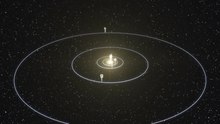HD 10180
|
Star HD 10180 |
|||||||||||||||
|---|---|---|---|---|---|---|---|---|---|---|---|---|---|---|---|

|
|||||||||||||||
| AladinLite | |||||||||||||||
|
Observation dates equinox : J2000.0 , epoch : J2000.0 |
|||||||||||||||
| Constellation | Little water snake | ||||||||||||||
| Right ascension | 01 h 37 m 53.58 s | ||||||||||||||
| declination | -60 ° 30 ′ 41.5 ″ | ||||||||||||||
| Apparent brightness | 7.33 mag | ||||||||||||||
| Typing | |||||||||||||||
| Known exoplanets | 6th | ||||||||||||||
| B − V color index | (+0.63) | ||||||||||||||
| Spectral class | G1 V | ||||||||||||||
| Astrometry | |||||||||||||||
| Radial velocity | (35.50 ± 0.14) km / s | ||||||||||||||
| parallax | (25.64 ± 0.03) mas | ||||||||||||||
| distance | (127.15 ± 0.15) Lj (39.00 ± 0.05) pc |
||||||||||||||
| Visual absolute brightness M vis | +4.4 mag | ||||||||||||||
| Proper movement | |||||||||||||||
| Rec. Share: | (−14.38 ± 0.05) mas / a | ||||||||||||||
| Dec. portion: | (+8.27 ± 0.04) mas / a | ||||||||||||||
| Physical Properties | |||||||||||||||
| Dimensions | (1.06 ± 0.05) M ☉ | ||||||||||||||
| radius | (1.11 ± 0.04) R ☉ | ||||||||||||||
| Effective temperature | (5911 ± 19) K. | ||||||||||||||
| Metallicity [Fe / H] | (0.08 ± 0.01) | ||||||||||||||
| Age | (4.3 + 0.5) bill. A | ||||||||||||||
|
Other names and catalog entries |
|||||||||||||||
|
|||||||||||||||
HD 10180 is a sun-like star in the Hydrus constellation , around 130 light years from Earth .
During a six-year study of radial velocity using the HARPS spectrograph at the 3.6 m telescope of the La Silla Observatory of the European Southern Observatory in Chile, it was found that the star is home to a planetary system of at least six, but probably seven planets.
Planetary system
- HD 10180 b is an unconfirmed item. The presumed planet is 0.02 AU away from the star, needs a little more than 1 day for one orbit and has a minimum mass that corresponds roughly to the mass of the earth.
- HD 10180 c is 0.06 AU away from the star (approx. 6 times closer than Mercury to the sun), takes 5.4 days to complete one orbit and has a minimum mass of approx. 13 earth or 0.04 Jupiter masses.
- HD 10180 d is about 0.1 AU away from its star, takes about 11.5 days to orbit and has a minimum mass similar to HD 10180 c.
- HD 10180 e is about 0.3 AU away from HD 10180 (slightly closer than Mercury to the Sun), takes about 60 days to orbit and is probably a gas giant with a minimum mass of about 0.08 Jupiter.
- HD 10180 f is 0.5 AU away from the central star (somewhat closer than Venus to the sun), needs 129 days for one orbit and has a minimum mass similar to HD 10180 e.
- HD 10180 g is 1.4 AU away from its star (similar to Mars near the Sun), takes about 1.7 years to complete one orbit and has a mass of about 0.07 Jupiter.
- HD 10180 h moves about 3.4 AU away from HD 10180, takes about 6.3 years for one orbit and, with about 0.2 Jupiter masses, is the exoplanet with the greatest minimum mass of the known planets in the system.
literature
- C. Lovis et al .: The HARPS search for southern extra-solar planets. XXV. Up to seven planets orbiting HD 10180: probing the architecture of low-mass planetary systems (PDF; 2.4 MB), published in: Astronomy and Astrophysics (August 13, 2010, English)
Web links
Commons : HD 10180 - Collection of images, videos and audio files
- Largest family of planets discovered , ESO press release(August 24, 2010)
- Encyclopedia of the Extrasolar Planets
Individual evidence
- ↑ a b c d e HD 10180. In: SIMBAD . Center de Données astronomiques de Strasbourg , accessed April 22, 2019 .
- ↑ a b Hipparcos catalog (ESA 1997)
- ↑ estimated from apparent brightness and distance
- ↑ a b c d HD 10180 c. In: Extrasolar Planets Encyclopaedia . Retrieved April 22, 2019 .
- ↑ HD 10180. In: NASA Exoplanet Archive . Retrieved April 22, 2019 .
- ↑ See "C. Lovis et al." under literature

